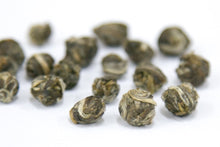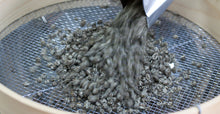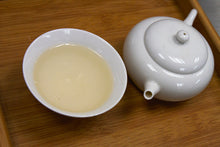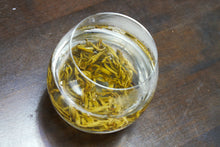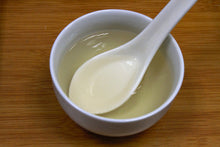
This jasmine tea is crafted exclusively from tender buds hand-picked in early spring, offering a remarkably long-lasting aftertaste and an exceptionally smooth mouthfeel. Its exquisite flavor comes from being repeatedly scented with fresh jasmine flowers, ensuring a natural and delicate floral aroma, unlike perfumed teas that rely on artificial additives.

This quality is developed specially for the European Market.
This is the first time for Malaysian to experience this quality. This tea was originally developed for the European high-end market.
There are 3 characteristics as follow:
1. Its flavor reminds you of Jasmine garden and it gives extremely mellow taste.2. Very easy to brew by anyone and not require any special tea ware.
3. Very economical.
Although this tea was meant for the high-end market, it is very casual and easy for anyone to enjoy.
This is the tea you should try first in our various lineups.

This tea is made of the young tea buds hand-picked in early spring. Each pearl is carefully hand-rolled. The base green tea pearl is then scented repeatedly with fresh jasmine flowers for 5 to 6 times overnight.
When brew, you can enjoy a pleasant flowery bouquet of Jasmine, with soft and smooth drinking sensation of tea taste lingering on palate.

Jasmine garden in Guangxi
Historical background
The Jasmine flower originated from Iran (formerly known as Persia). It has been planted in China mainland for more than 1700 years; it is said that this flower was brought to China during Tang Dynasty through the Silk Road. In the very early stages, it was only served for decorative purposes. The history of making flower tea using jasmine started during the South-Song Dynasty (南宋 Nan-Song, at around 1240) at Guangdong province. During Ming Dynasty (明代 Ming-dai), the technique of scenting tea with jasmine had been well-developed. Details of the scenting process had been recorded, including selection of raw material, quantity of flower used, number of scenting process, drying, etc. The commercial mass production of Jasmine tea emerged during the Qing Dynasty, at Fuzhou (福州) of Fujian province. In year 1900, the production of jasmine flowers at Fuzhou reached 1,500 tones. During its most flourishing period (1928-1938), the quantity of jasmine tea being produced was more than 7,500 tones per year. By the end of the 19th century, the foreign traders started to set-up tea shops at Fuzhou, and jasmine tea had became one of the trading items to overseas.
Growing Area of Jasmine Flower
The increased popularity of jasmine tea gave impetus to the massive production from the Southern part spread to the Northern and East, i.e., Zhejiang (浙江), Jiangsu (江苏), Sichuan (四川), Hunan (湖南), Guangxi (广西) and Yunnan (云南) Province. However, at Jiangsu, Zhejiang and other northern provinces, the jasmine flower could not survive under the cold weather during winter; the flowers were planted in pots and needed to be transferred indoors to a warmer temperature. This increased the cost of production and impeded the immense development at Jiangsu and other provinces located at the north.
Other than mainland China, the fragrance of jasmine had even drawn the attention of tea merchants in Taiwan. As early as year 1873, they started to ship tea leaves to Fuzhou at Fujian Province to process into jasmine tea. Later, in year 1882, Taiwan tea merchants brought back the jasmine seeds and cultivated it in their island: they started to produce jasmine tea on their own. Until year 1939, the yield of Taiwanese jasmine flowers reached 1300 tones per annum. However, due to the influence of sea-island climate, the fragrance of jasmine flower gives a less refreshing note as compared to the one produced in China.
Since year 1980, the state government of Guangxi Province made the utmost effort to develop the production of jasmine flowers. At the same time, the Commercial Department appointed Heng County (横县 Heng-xian) at Guangxi as the new base for the production of jasmine flowers. This has promoted the enormous development, and today, Guangxi has the widest and renowned jasmine garden, and the largest jasmine tea processing area is located at Heng County in Guangxi Province.


Ideal Growing Environment of Jasmine Flower
The jasmine flower is native to tropical and warm temperate regions with average atmospheric temperature above 20˚C. By far, Heng County at Guangxi Province has proven to be the most suitable place for the jasmine flower. This area is located at the sub-tropical monsoon climate zone. With this climate, the jasmine plant can easily over-go the winter without being frozen and ruined by the cold stream. The sufficient rainfall and sunshine is favorable to the growth of jasmine flowers. During the blossoming period, the atmospheric temperature which is above 25˚C is favorable. Besides, the soil condition is rich in organic substances which ensure exuberant growth of plant. The jasmine plantation is located at the flat ground and hillside with good drainage and receives sufficient sunlight. The florescence of jasmine starts earlier and lasts for a longer period of time than other areas, and the yield is higher. Besides, the naturally fertile soil condition gives rise to the flower bud which is bigger and gives a stronger fragrance. This can effectively reduce the quantity of flowers used for scenting; e.g., the amount of flowers used is only 70% compared to other areas.

Tea Used for Jasmine Tea
The tea leaves used to make this jasmine pearl comes from the organic tea garden located at Ningde City (宁德市 Ning-de Shi) at Fujian Province. At Ningde City, the organic tea garden covered up to 70% of its total tea garden found here. This naturally preserved area is surrounded by several mountains. Besides, there are at least 24 main river streams crossing this area at various locations. Subsequently, the tea growing area is surrounded with fog throughout the year. One of the essential factors for good green tea is its mellow taste. This taste originates from amino acid called theanine. Young buds contain high levels of theanine, but it is converted to polyphenol such as catechins when tea leaves receive sun light. On the other hand, less sunshine will preserve high levels of theanine in the leaf as bio-conversion is not effectively taking place. Other than giving the mellow taste due to the substance contained in leaf, the optimum growing environment produce more fleshy buds and leaves, which gives a more refined outlook when rolled into pearl shapes.
3. Cultivars and Plucking of Jasmine Flower
There are several jasmine cultivars planted in mainland China. In general, there are three main categories referring to the structure of flower petals. Hojo’s Jasmine Pearl is particularly scented with Double-Petal Jasmine flowers to obtain its natural intense fragrance.
Single-Petal Jasmine (単瓣茉莉 Dan-ban Mo-li)
In the early stage (before year 1963), this is the main cultivar planted for the production of jasmine tea The flowers blossom at an earlier hour (6-7 p.m.) as compared to the Double-petal jasmine (at 8-9 p.m.). This cultivar gives a fresh note of bouquet and with a refreshing taste to the jasmine tea. However, the yield is much lower (1400-1750 kg/acre, 2800kg/acre at maximum), as compared to Double-petal jasmine (3500-5600 kg/acre, 10500kg/acre at maximum). Besides, this cultivar is susceptible to plant disease and is not able to bear the cold weather and water logging condition during the rainy season. These factors are unfavorable to the overall performance although it gives a good fragrance.

Double-Petal Jasmine (双瓣茉莉 Dan-ban Mo-li)
Due to the above factor, other cultivar was developed and up to date, the Double-petal jasmine is the main cultivar being planted at most of the flower gardens. Other than producing a much higher yield of flowers, it can withstand harsher weather conditions and environment, and it is easy to plant. Besides, this cultivar gives a stronger and more intense fragrance. It is favorable for the production of jasmine.
Multi-Petal Jasmine (多瓣茉莉 Dan-ban Mo-li)
After plucking, the flowers will blossom at 7-8 p.m. Usually the 1st and 2nd outer layer of petal will blossom, and the rest of petal may blossom on the next day, or even sometimes never blossom but shrivel. The full blossoming of flowers will drag for many hours, and gives a milder fragrance. However, the yield is lower. Therefore, this cultivar is not suitable for the production of jasmine tea and less is being used.
The flowering season of jasmine vary in accordance to different areas due to the variance of atmospheric temperature. In general, there are four main seasons:
- 1)Spring - Named as 春花汛 (Chun-hua Xun), usually at around May ? June, the yield is around 15% of total quantity in a year.
- 2)Summer - Named as夏花汛 (Xia-hua Xun), usually during July, the yield is around 30% of total quantity in a year.
- 3)Late summer - Named as伏花汛 (Fu-hua Xun), during August, the yield is around 30% of total quantity in a year.
- 4)Autumn - Named as秋花汛 (Qiu-hua Xun), during September to October, the yield is around 25% of total quantity in a year.
During spring, due to the lower temperature, and less accumulation of nutrition in plant, the yield is lower and of inferior quality. During early spring and late autumn, the flower is rather small with a yellowish color and hardly blossoms after plucking; it is not suitable for the scenting process. The best season for jasmine flower falls during summer until late summer. At this time, the temperature is higher, and there is sufficient sunlight and rainfall. These factors are favorable for the jasmine plant to produce more flowers with bigger buds and of superior quality.
The plucking of jasmine flower is meticulously carried out in order to collect the right flower. The standard is set based on whether the flower plucked is able to blossom at night. The criteria must be as follows:
- 1) Select the “right flower’, which is named as当天花 (Dang-tian Hua). The characteristic of the right flower is: full petals in white color, with long stalk, i.e. the distance between corolla (花冠 Hua-guan) and calyx (花萼Hua-e, the protective outer layer of leaves on a bud) must be far enough.
- 2) Do not pick the green bud (called 青蕾 Qing-lei). This is the flower without full petal and smaller size, not in white color but mix with greenish yellow color. The green bud is immature and will not blossom.
- 3) Do not pick the white flower (called 白花 Bai-hua). This is referring to the flower which has already blossomed and most of its fragrant oil has vaporized.
Tea
Ningde is known as the Kingdom of Tea Cultivars; here , it contains up to 11 cultivars of National Standard, with another 14 cultivars of Province Standard. In particular, Fu-yun No.6 (福云6号) and Fu-ding Big-white down (福鼎大白毫 Fu-ding Da-bai-hao) is the main cultivars used. For these cultivars, the budding occur at earlier stage compared to others and have a higher budding rate. The Fu-yun No.6 gives more fleshy leaves, while the Fu-ding cultivar has a more fleshy and robust bud that is covered with a lot of white down. With these factors, the pearl formed gives a more distinctive appearance in addition to its taste.
The plucking of fresh tea leaves starts during March. Usually, one bud with two or three leaves is hand-plucked. After plucking, the leaves are transferred to a cool place indoors . The leaves are then spread to a thin layer. It must be carried out with much care and attention so as not to cause damage to leaf (damaged leaf will turn red and affect the quality of the end product). During this period, water vaporized from the fresh leaves is reduced to about 70%. The spreading causes the leaves to omit greenish grassy smell, reduce the bitter and astringent taste, increase amino acid concentration which improves the briskness of liquor.
4. Process - Intensive manual work by the expert
The process involves intensive manual process to obtain the jasmine pearl. The green tea is processed at early spring and kept until the jasmine flowering season comes, i.e. starting from June onwards. The scenting process involves meticulous care to preserve the flower in order to obtain its divine fragrance into tea leaves.
Process of Green Tea Leaves used for Jasmine Tea? Do you know why Premium Jasmine tea is in the pearl shape?
Premium Jasmine tea is in its pearl shape. Do you know the reason why it has to be in this shape?
Tea leaf is made into the pearl shape which is the similar size and shape of jasmine flower so that when they conduct the mixing, tea leaf and jasmine flower could be very well mixed and the leaf could be effectively scented.
After plucking, the tea leaves will undergo 4 main processes:
(a) 殺青 (Sha Qing) – Inactivation of Enzyme (Blanching)
This process is carried out using the drum or steamer heated at 260˚C. The purpose of 殺青 is to inactivate oxidative enzyme such as polyphenol oxidase (PPO) with heat. With high temperature, it takes very short time to heat the tea leaves to above 80˚C and inactivate oxidative enzyme. It will prevent the leaves turn to red color which is caused by enzymatic activity. In the meantime, the high temperature is causing the vaporization of greenish grassy flavor of fresh leaves. Besides, leaves become softer after loosing water caused by heat. This is required to form the desired shape during the subsequent rolling step. After the blanching, the soften leaf is rolled to form the strip-shape.
(b) 烘焙 (Hong-bei) – First Drying
At this first drying step, the leaf is dried using machine to a moisture content of 30%, then spread and cooled down.
(c) 揉捻 (Rou Nian) – Rolling – Forming the pearl shape
After cooling, the leaf is proceeding for hand-rolling process. Intensive manual work is done to roll the leaf into the pearl shape. In a day, even an expert can only manage to roll as much as about 2kg of pearls.
(d) 干燥 (Gan-zhao) – Drying
The formed pearl will be dried using the machine. Two steps of drying are carried out: the 1st drying at 110-120˚C, followed by 2nd drying at lower temperature, i.e., 95-105˚C. The semi-finished tea contains about 7% of moisture.
The dried pearls will be kept until the florescence season of jasmine flower. During the storage, the water content of pearl must be controlled below 9%, and keep in air-tight condition and prevent from direct sunlight and humid environment.
Before the scenting process, the tea leaves must be re-conditioned:
分級 – Separating
Pearl will be carefully separated according to different sizes. Besides, it is sifted in order to remove broken pieces, tea dust or flakes
復火 (Fu-huo) – Re-drying
The semi-finished tea will be dried in machine heated to 100-110˚C and reduced the moisture to 4-4.5%. The lower temperature is used to prevent the leaves become burnt and affecting the quality of made tea. The purpose of re-drying is to vaporize the excessive moisture trapped in leaves during the storage time. It helps to eliminate the unpleasant stale flavor from leaves.
冷却 (Leng-que) – Cooling
After the drying, usually the temperature of pearl is at 60-80˚C. The dried pearl will be spread out and cooled down to temperature which is 1-3˚C higher than ambient temperature. If the pearl retains higher temperature, it will affect the scenting process. The blossom of jasmine flower is very sensitive to changes of temperature and lower temperature is favorable.
Preparation of Flower for Jasmine Tea
The freshly plucked flower must be well-taken care of following several steps:
Cooling of Flower
During the transportation of flowers to the factory, the temperature of flowers are gradually increased up to nearly 38?C due to stacking and respiratory effect of flower. This is unfavorable to the physiological activity of flowers and will affect its blossom at the later stage. The flowers must be spread to a thin layer with a thickness of 10 cm for cooling down. If the flower is plucked after the rain, it has to be spread to an even thinner layer and blown with fan to accelerate vaporization of water.
Curing of Flower
The purpose of curing is to strictly control the temperature of piled flowers. This is the critical step to ensure the quality of the blossoms. Jasmine flower is sensitive to changes of temperature when it blossoms. The optimum temperature is 32-37?C. If the temperature of piled flowers is lower than 30?C, it is stacked to a thicker layer to keep-up the temperature up, whereas the flower is spread to a thinner layer when the temperature is above 38?C. During spring and autumn, the room temperature is lower. Usually the flowers are piled up to 30-40cm and even covered with cloth in order to keep-up the temperature.
Sieving of Flower
When 60% of the flowers bloom, sieving is carried out. The purpose of sieving is to separate the flower according to its different size. Besides, it also removes the green bud and stem. Only the flower with the right size will be collected and used. This is important to ensure the blooming occur simultaneously during scenting.
Mixing of pearl with jasmine flower - the perfect care as first class
This is the critical step in the scenting process which affects the quality of finished product. There are six crucial factors:

1) The ratio of pearl: flower
The quantity of flower used is related to the grading of end product. In general, the higher grade used more flower than lower grade. In order to produce 100kg of special grade jasmine pearl, the total of 100 kg of flower will be used. The 100kg of flower is divided for 4 times of scenting: 1) First scenting – 38 kg, 2) second scenting – 30 kg, 3) third scenting – 26 kg, 4) final scenting – 6 kg. For first grade, 3 times scenting is carried out without final scenting, and the number of scenting is reduced when for lower grade. For 4th grade and above, the tea is first scent with waste flower (花渣 Hua-zha) collected from the final scenting of other high grade tea.
【Mixing Between Green Tea and Jasmine Flower】
The whole process of mixing is carried out manually. At first, the total quantity of tea and flower is separately divided into 3 – 5 portions. The first portion of tea will be spread to a layer with thickness of 10-15cm, and then the first portion of flower will be scattered on top of tea. This is repeated layer by layer.
When it is done, the worker will use the harrow to separate and blend the mixture, and leave it for 5 – 6 hours before the ventilation step.
通花 - (Tong-hua) – Ventilation
The purpose of ventilation is 1) to reduce the temperature of mixture, 2) provide oxygen to flower for continual blooming, 3) release the carbon dioxide and others from mixture. The worker will use the harrow to rake and spread the mixture to thickness of 10-15cm. It is repeated every 15 minutes and continues for 1 hour. When the temperature of mixture dropped to about 33-38˚C, the mixture will be piled again to the thickness of 30cm and leave it for 5-6 hours again. At times, second ventilation is necessary if the temperature of piled mixture rise to around 40˚C again.
In total, the scenting process takes 10-12 hours. When the temperature of mixture increase > 40˚C again, the flower became shriveled and turned to yellowish color, and not producing the fragrance, it is time to remove the flower.
起花-(Qi-hua) – Separate the flower
Once the scenting is accomplished, the exhausted flower must be removed immediately. If delay, the flower became stewed and giving the unpleasant smell to tea. The timing of separating the flower must follow the rules:
1) When the temperature of piled mixture reached 41˚C in first scenting, 40˚C in second scenting, and 38˚C in third scenting, respectively.
2) When the moisture content of piled mixture reached 17-18% in first scenting, 13-14% in second scenting, and 11-12% in third scenting, respectively.
烘焙 (Hong-bei) - Drying
After the first scenting, the tea is dried in order to reduce the moisture content. The temperature of drying is depends on the number of scenting:
- First scenting – 110- 120˚C, the moisture is reduced to 5-5.5%
- Second scenting – 100 – 110˚C, the moisture is reduced to 5.5-6%
- Third scenting – 90 – 100˚C, the moisture is reduced to 6-6.5%
After drying, the temperature of tea must be reduced to < 40˚C. Tea is then ready for subsequent scenting process (转窨 Zhuan-yin, means repeat scenting).
提花(Ti-hua) - Final scenting
This is one of the secrets that give the very genuine fresh flowery note to the tea. The final scenting is carried out in order to increase the intensity of jasmine fragrance, and adding the natural and refreshing flowery note to tea. Only the top grade of jasmine flower is used: with big petal, white color, and strong fragrance. For every 100 kg of tea, the flower used is 6-8 kg, depending on the moisture content of tea. In order to preserve most of its fragrance, the tea will not be dried after final scenting. Therefore, the moisture content of tea prior to final scenting is checked, and the quantity of flower used is calculated. The mixture is well-blended and piled for 6-8 hours. The moisture of final product is controlled below 8.5%. Exhausted flowers are removed once the scenting is accomplished, and jasmine tea will be packed into carton.
Recommended Brewing Method
Water for Brewing
In you are using tap water, it is necessary to use a water filter that consists of activated carbon filter. Otherwise, you wouldn't be able to enjoy the authentic taste of tea. If using a commercial mineral water, it is important to choose the natural mineral water. Never use distilled water or reversed osmosis processed water. These water lack of mineral content and thus the taste of tea is too soft and a little plain. Soft water is better than hard water. Brewing tea with hard water makes taste bitter while soft water makes taste gentle and sweet. The softness of water is written on the mineral water bottle as TDS: total dissolved solid. You need to choose the water that TDS is below 200mg/liter.
Use fresh water which has not been boiled before. Bring the cold water to boil and cool down until required temperature. This is to evaporate some chlorine from the water.
Using a Teapot
Hot water: leaf weight = 1:50 (4g of leaf for 200ml of water)
Temperature: 80-85 degree C
- Rinse teapot with boiling water so as to warm it up.
- Place green tea according to the above ratio.
- Let the boiled water to cool down to 80-85˚C. Green tea leaves prefer a slightly cooler temperature, while boiling water is used for fermented tea like black or oolong tea .
- 4. Gently pour water onto the leaves. Place the lid and brew for about 1 minute.
- After one minute it is ready to drink. Please make sure completely pour off. If hot water remains inside teapot, it will damage tea leaf while tea is waiting for subsequent brewing. Hence it is necessary to use a pitcher so that you do not have to keep tea inside teapot.
- Please remove the lid while you are waiting for subsequent brewing. Tea leaf will be over steamed and get oxidized if the lid is not removed.
- For 2nd brewing, brewing time is about 10 seconds and third brewing onwards, please add 10 seconds for each subsequent brewing.





